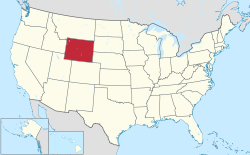This article may rely excessively on sources too closely associated with the subject , potentially preventing the article from being verifiable and neutral.(January 2019) |
| Agency overview | |
|---|---|
| Formed | 1973 [1] |
| Preceding agency |
|
| Jurisdiction | State of Wyoming |
| Headquarters | 5400 Bishop Blvd. Cheyenne, WY 82006 41°10′06″N104°50′32″W / 41.168445°N 104.842154°W |
| Agency executive |
|
| Website | wgfd |
| Map | |
 Wyoming Game and Fish Department Jurisdiction within the State of Wyoming in the United States, highlighted in red. | |
The Wyoming Game and Fish Department is the State of Wyoming's state agency charged with stewardship of the state's fish, game, and wildlife resources. The department sets fish and game regulations, including issuance of hunting and fishing licenses and enforcement of state regulations throughout the state. The department also enforces watercraft regulations and registration, along with enforcement of invasive species laws. The agency is headquartered in Cheyenne. [3]